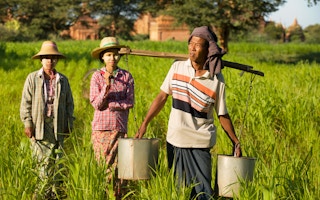Southeast Asia is facing a looming crisis: It is losing its farmers faster than it can improve its agricultural productivity, which has serious consequences for food security. But returning migrant agricultural workers, full of overseas farming experience, can potentially relieve the region of this anxiety.
Farming labour numbers are dropping mostly due to the older generation retiring and the younger generation not being interested in the sector. Farmers are being pressed by factors such as yield reduction from environmental pressures, volatile commodity prices, rising input costs, limited access to credit and insurance, and many others.
This is causing would-be farmers to move overseas for better wages. Southeast Asia is the origin of 8 per cent of the world’s migrants. They mainly hail from rural areas of Cambodia, Indonesia, Myanmar, the Philippines, Thailand, and Vietnam. They work primarily in agriculture, construction, manufacturing, and shipping. For example, 32,500 out of the 222,500 farm workers in South Korea in 2021 were from Cambodia.
The scale of those working overseas is quite large. These migrants contribute significantly to the GDPs of their own countries. For example, transfers to the Philippines are equivalent to approximately 9 per cent of its GDP (US$39.1 billion in 2023. See Table 1). The number of Southeast Asians moving overseas is expected to continue to rise due to host nations’ acute labour needs, and more competitive and stable wages.
Table 1: Remittance to SEA nations as a proportion of GDP, 2023

Source: World Bank / ILO
Due to these factors and others, in just over 20 years, Southeast Asia has seen a rapid reduction in the proportion employed in agriculture (Figure 1). This proportion has halved in Vietnam, Cambodia, and Thailand. Indonesia’s Ministry of National Development Planning has predicted that, without action, the Indonesian farmer may be extinct by 2063.
Figure 1: Proportion of those employed in agriculture between 1991-2023

Source: ILO / World Bank
This crisis coincides with Southeast Asia’s increasing exposure to climate change-induced extreme weather, sea level rise and saline intrusion, drought and floods, which will impact agriculture and food significantly. Arable land in Southeast Asia is expected to decline by 2.6 and 22.5 per cent by as early as 2028 as a result of climate change. Production, too, is expected to drop – rice yields are projected to decrease by as much as 40 per cent by 2100 under future climate conditions.
The migration of able-bodied farmers leaving flagging farms behind is contributing to Southeast Asia’s looming food insecurity. Yet, this challenge can also be turned into an opportunity. It requires home nations to shift their perspective of seeing farmers moving overseas as a loss to a potential solution – that they can, on return, contribute to their countries’ food resilience in the face of climate change.
Governments could recognise that returning migrants can pick up modern and effective farming skills and apply these at home. Activating and leveraging these agricultural resources require proactive action by governments to ensure that they do, indeed, return as skilled agricultural talent and not just remain as low-skilled labourers.
Home nations can work bilaterally, or potentially multilaterally, through Asean or the International Labour Organisation (ILO), to encourage host nations to extend climate-resilient farming training such as the use of climate-resilient seeds, soil health management, crop rotation, and smart agricultural methods such as efficient irrigation, sensor-based input management, and automation to these workers.
Language compatibility, time, and financial resources will be challenges, but employers and workers who think long-term and see value could be convinced to invest in this. Incentives may also improve participation.
Secondly, home nations must be able to harness these upskilled workers on their return home. This is predicated on countries continuing to improve support for their citizens on their migration journey, including improving pre-departure orientation, in-country assistance, and reintegration programmes.
The Philippines already has well-developed policies on this. Ecuador’s programme goes one step further with its “Returning Migrant, Ecuador is with you” programme. Sri Lanka has skills-matching services for returnees. Currently, few Southeast Asian governments do this well. Governments may first have to build up trust before migrating workers are convinced to use its services.
These returning agricultural talent could be connected to farmland-matching services, small grants programmes, micro-financing options, localised agriculture training or extension services to improve their farms. They may also benefit from entrepreneurial and business skills training, financial literacy, marketing, supply chain management, and business planning to become successful agri-preneurs who launch new farms.
Through entrepreneurial endeavours, they can create job opportunities, connect local produce to export markets, and spur local economies. Returning migrants can be powerful agents of change, improving food resilience at home in the face of climate change.
Home countries should celebrate such success stories to sustain the movement of agricultural labourers to farmers, which could inspire others to follow suit. These can serve as compelling testimonials to demonstrate transformative potential and encourage home and host governments to continue to invest in such initiatives.
A paradigm shift is needed: with the looming threat of climate change, Southeast Asia needs to start actively collaborating with the global north to upskill its citizens overseas in climate-resilient and smart agriculture, and investing in these returning agricultural talent. Naturally, participation rates and available resources are a constraint. However, if done successfully, these initiatives could reverse the trend of declining farmer numbers in Southeast Asia and build climate resilience in agriculture for longer-term food security.
This article was first published in Fulcrum, ISEAS – Yusof Ishak Institute’s blogsite.











